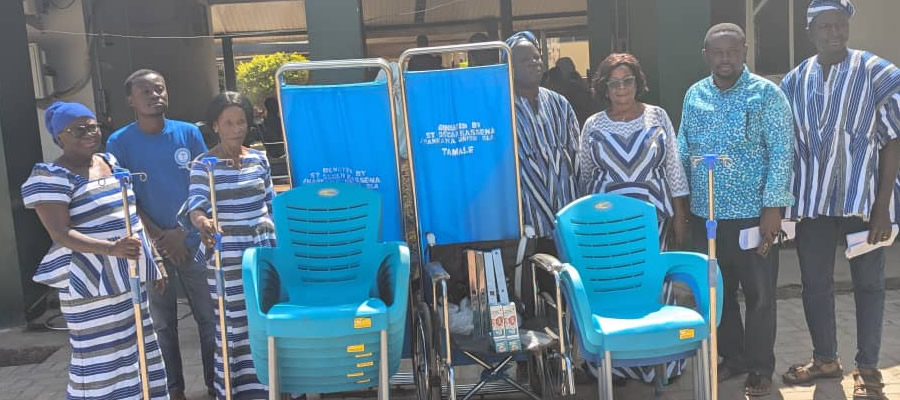

Health care in the Municipality meant for the prevention of diseases and promotion of healthy lifestyle, is decentralized to bring quality health care closer to the people.
The Assembly is privileged to have quite a number of health facilities to meet the health needs of the people. The War Memorial Hospital located in the capital (Navrongo) is the Municipal Hospital and a referral centre to the other health facilities at the Zonal and community level. It also has a number of Pharmaceutical facilities or drug stores that offer medical services to clients especially the sick.
Type of Facility Number
• Pharmacy 1
• Drug Stores 13
There are inadequate health personnel. The Assembly currently has a Doctor/Patient ratio of 1:20,000 and Nurse/Patient ratio of 1:1,200. Both the Doctor/Patient and nurse-patient ratios do not give a good picture of the required manpower for effective health care delivery services in the District. The phenomenon being faced now is undue pressure on the existing personnel which does not auger well for efficiency.
NAME OF HEALTH FACILITY NO.
Hospital 1
Health Centers 2
CHPs Compounds 15
Health Research Centre 1
Health..Post (Catholic Mission) 1
Private Clinic 1
Nutrition Centers 2
Health Facilities
It is equipped with a number of health facilities. The Navrongo War Memorial Hospital located in the capital, serves as referral point to all health centres and clinics in the district. There are three Health Centres in the district; twenty-five CHIPS Compounds; three health posts being run by the catholic; one private clinics; one health Research Centre; and sixteen Chemical sellers (Table 1.10.1.1). Another good way to assess the efficiency of health institutions is the bedding status at the health facilities. Table 1.10.1.4 below shows the bed status from 20003 to 2005.1.
Health Staff
There are inadequate health personnel . It has a Doctor/Patient ratio of 1:75,488 and Nurse/Patient ratio of 1:5,245 (Table 1.10.1.1). However, there are a number of staff from the Health Administration that support the other health personnel to fully tackle health problems in the municipality. From table 1.10.1.2 above, the number of practicing doctors has remained two from 2003 to 2005. However, there have been two Cuban doctors supporting the two Ghanaian doctors at the District Hospital. Also, the doctors at NHRC from time to time do provide their services at the hospital when the need arise. The table 1.10.1.2 above shows improvement in nurse- patient ratio from 2003 to2005. This is due to the Assembly’s conscious effort of sponsoring nursing trainees and the establishment of the Community Health Nursing Training School in the district.
Disease Control
With limited access to health care facilities and unhealthy lifestyles of the residents, life expectancy is below the national average of 55 years. Malaria is endemic in the Kassena-Nankana accounting for over 60% of all outpatients seen at health facilities and 25% of under five mortality in the district. The top ten (10) diseases are shown in table 1.10.1.2 below. From table 1.10.1.2 above malaria continues to rank first on the ten (10) causes of OPD attendance in the district. Interventions to control malaria have been intensive yet cases keep on rises
It should be noted that distribution and re-treatment of insecticide treated bed nets to under 5 and pregnant women were carried out with support from UNICEF. Community volunteers and women’s group leaders were trained on the new malaria drug (artesunate –amodiaquine)
Nutrition
Nutritional problem is second to diseases that are environmentally originated. This makes it more imperative for issues on nutrition to be seriously addressed. In view of this, a lot of measures have been put in place to ensure that the nutritional levels of the residents are improved.
Mention can be made of the Nutrition Rehabilitation Centre, Supplementary Feeding, Micro-Nutrient Deficiency Control, Infant Feeding, Growth Monitoring Promotions, Static Clinic, Outreaches, Nutrient Behaviour Change and Communicating.
The table 1.10.1.3 below is a survey conducted by the Health Administration at the Nutrition Rehabilitation Centre.
The table above indicates a reduction in the number of malnourished children from 2003 to 2005. This improvement was due to establishment of Nutrition Feeding Centres where children under 5 are fed; pregnant and lactating mothers are given dry food ration. Nutrition and health education sessions were also intensified.
Health Education
The MHA ensures that health education activities ranging from public address systems to talks with individuals are organized. This is paramount in ensuring the course of work performance of the health institutions through durbars, community meetings and promotional health talks at the service points. Communities are sensitized to report early for treatment. School health activities are also carried out in the district. School children from Pre-schools, Primary 1 and 3, JSS 1 and SSS 1 are examined and referrals made for further treatment. Girls are also immunized from age 14 against tetanus.
Reproductive And Child Health Services
The MHA carries out Reproductive health activities in all health facilities in the district, which cover maternal, and child health services, family planning and adolescent reproductive health services. The service is mainly preventive and curative. It also embodies proper management of labour and abortion.
In addition to the above reproductive health, staff carry out immunization exercises at static clinics, outreaches in the communities and house-to-house immunizations through home visits, routinely and supplementary immunization exercises. Reproductive health in the past half year covered not only women but also men to bring about healthy productivity. Recently, CHIPS has been the main focus of the district reproductive health activities.
Health Insurance
The Municipality has established Mutual Health Insurance Scheme to improve people’s health and life conditions through increasing access to health care services. The scheme provides opportunity for all people, especially the vulnerable, who have registered under the scheme to access health care services without out-of-pocket payment being required at the point of service delivery.
More importantly, children under 18 years, the aged (70 years and above) and the indigents (the very poor who could not afford to pay the premium) are being taken care off by the scheme. Table 1.11 below indicates the number of residents who have registered with the scheme since its inception in 2005. From table 1.11 above, by the closed of the year 2005, the first year of operation, 14,336 persons representing 9.6% of the total population had registered and benefiting from the scheme. The operationalization of the Health Insurance Scheme has really increased people’s access to health care services thereby improving their health status.
Factors that spread HIV/AIDS
Poverty runs top on the list of causes, which compel people into wayward behavioural habit. Mother to child transmission and the use of sharp materials used by infected people also aid the spread of the virus. Polygamy and other traditional practices such as FGM undoubtedly promote the spread of the virus. Majority of the youth who migrate to the southern parts of the country during the long dry season in search of non-existing jobs later indulge in unsafe sexual behavioural patterns, which undoubtedly, increases their risk of acquiring the virus. Paga being an Inland Port or transit point on the Trans-ECOWAS Route serves as a great threat to the spread of the HIV/AIDS menace.
Repercussions of HIV/AIDS on Local Economy
The prevalence of the virus in the KNE is likely to have the following socio-economic effects:
- Increased number of orphans, distressed and street children
- Increase child labour
- Pressure on the inadequate health facilities
- Low productivity
Date Created : 11/21/2017 1:55:37 AM











 facebook
facebook
 twitter
twitter
 Youtube
Youtube
 +233 593 831 280
+233 593 831 280 0800 430 430
0800 430 430 GPS: GE-231-4383
GPS: GE-231-4383 info@ghanadistricts.com
info@ghanadistricts.com Box GP1044, Accra, Ghana
Box GP1044, Accra, Ghana